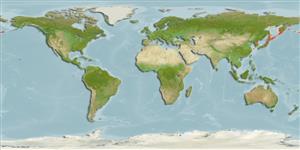>
Perciformes/Cottoidei (Sculpins) >
Cottidae (Sculpins)
Etymology: Stelgistrum: Greek, stelgis, -idos, stleggis = diminutive of strougis = brush (Ref. 45335).
Eponymy: Dr Leonhard Hess Stejneger (1851–1943) was a Norwegian-born ornithologist and herpetologist who settled in the USA, where he became the USNM’s vertebrate expert. [...] (Ref. 128868), visit book page.
More on authors: Jordan & Gilbert.
Environment: milieu / climate zone / profondeur / distribution range
Écologie
marin démersal; profondeur 18 - 320 m (Ref. 50550). Polar
Northwest Pacific: Hokkaido to the northern Sea of Japan and the Sea of Okhotsk.
Taille / Poids / Âge
Maturité: Lm ? range ? - ? cm
Max length : 9.0 cm TL mâle / non sexé; (Ref. 56557)
Life cycle and mating behavior
Maturité | Reproduction | Frai | Œufs | Fécondité | Larves
Masuda, H., K. Amaoka, C. Araga, T. Uyeno and T. Yoshino, 1984. The fishes of the Japanese Archipelago. Vol. 1. Tokai University Press, Tokyo, Japan. 437 p. (text). (Ref. 559)
Statut dans la liste rouge de l'IUCN (Ref. 130435: Version 2024-2)
Menace pour l'homme
Harmless
Utilisations par l'homme
Outils
Articles particuliers
Télécharger en XML
Sources Internet
Estimates based on models
Preferred temperature (Réf.
123201): 0.1 - 12.6, mean 1.8 °C (based on 86 cells).
Phylogenetic diversity index (Réf.
82804): PD
50 = 0.6250 [Uniqueness, from 0.5 = low to 2.0 = high].
Bayesian length-weight: a=0.00955 (0.00344 - 0.02648), b=3.09 (2.85 - 3.33), in cm total length, based on LWR estimates for this (Sub)family-body shape (Ref.
93245).
Niveau trophique (Réf.
69278): 3.3 ±0.5 se; based on size and trophs of closest relatives
Résilience (Réf.
120179): Milieu, temps minimum de doublement de population : 1,4 à 4,4 années (Preliminary K or Fecundity.).
Fishing Vulnerability (Ref.
59153): Low vulnerability (10 of 100).
🛈
